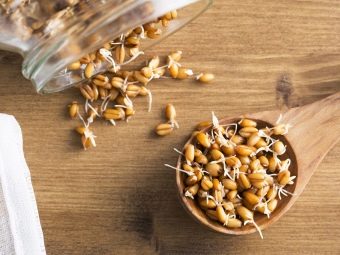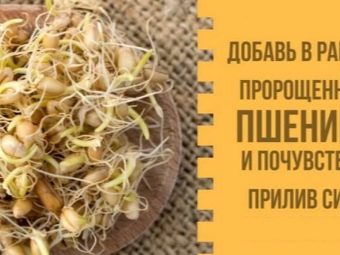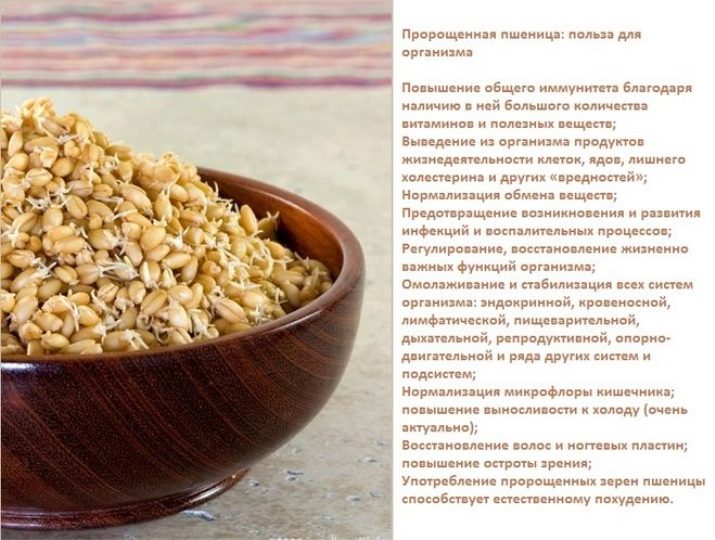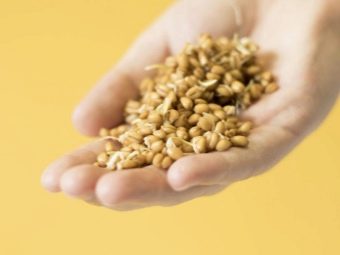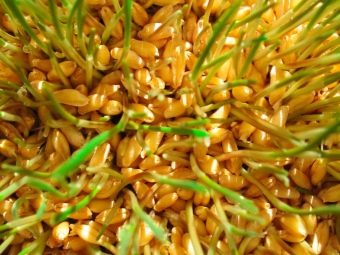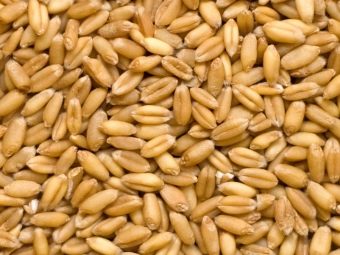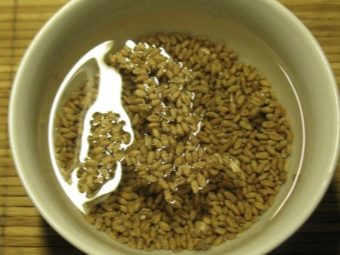How to germinate wheat at home and how to use it?
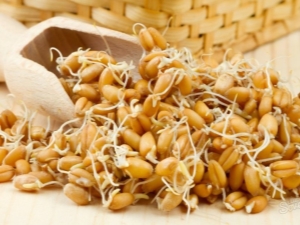
Wheat today is even more popular than at the time of its appearance.The cult of proper nutrition is increasingly talking about the benefits of germinated seeds and sprouts. How to germinate wheat correctly? What mistakes should be avoided during sprouting? Are there any contraindications to its use?
The benefits and harm of sprouts
Wheat appeared in the life of civilizations 9000 years ago BC. e. Its homeland is considered to be East Asia, the Transcaucasus and Iran. In Russia, the mention of wheat appeared more than 15,000 years ago. Even in the Bible there is a mention of this valuable cereal.
And today this grass is valuable, irreplaceable and one of the most frequently used all over the world. It is made from flour, various kinds of pastries, bread, pasta, pasta, pizza, pancakes, muffins, dumplings, dumplings and much more.
According to official sources, almost half of the land suitable for planting is devoted to the cultivation of wheat. No wonder they say that bread is the head of everything!
However, in recent decades, in connection with the emergence of the cult of healthy and proper nutrition, a lot of information has appeared on consumption, in addition to our usual grains, seedlings and wheat germ.
This is due to the fact that, according to research scientists sprouts and sprouts have tremendous power and contain a lot of substances that are useful to man.
- They contain a large amount of protein, which contributes to the strengthening and growth of muscles, nails, teeth, bones.
- Due to the low carbohydrate content, it has a low glycemic index, which, as a food product, is indicated for people suffering from diabetes.
- The high fiber content that wheat has is shown to people struggling with excess weight. After all, it increases the intestinal motility and promotes weight loss.
- It contains monounsaturated acids, which contribute to the proper functioning of the digestive system and remove even very old slags from the intestines with prolonged use.
- B vitamins are nutrition for the human nervous system. Wheat is one of the first places on the content of this vitamin.
- Vitamins A and E are responsible for the growth and appearance of nails, hair and skin. Rich in these vitamins and wheat germ. Naturally occurs rejuvenation of the skin, hair and the whole body.
- As in other natural seedlings, a large amount of calcium, chromium, copper was found, which strengthen the body. With the participation of calcium, 90% of all processes in the body occur, therefore it is impossible to speak about its excess in the body in the existing conditions.
- The very strong energy contained in the sprouts helps a person fight free radicals, which are harbingers of cancer. Not for nothing, even more often doctors in the identification of oncology appoint wheat seedlings.
- Increasingly, the results of studies of wheat seedlings reception to improve the patients' vision appear on the Internet. In some cases, about 80% of people who have lost their sight have been able to restore it using only this useful grass and special gymnastics.
- People suffering from constipation, with regular use of wheat germ with large amounts of water, note improvements in the intestinal function without the use of other medicines.
You can still talk a lot about the benefits of this beautiful product. But unfortunately, he also has contraindications. It is not recommended to use sprouts and wheat sprouts:
- people suffering from diarrhea: the risk of causing dehydration increases;
- those who have kidney disease and some diseases of the gastrointestinal tract;
- Those who suffer from the disease of civilization and have gluten intolerance - it's better not even to experiment.
Children should be given seedlings with extreme caution, because the children's body is very susceptible to unusual products. It is also necessary to refuse to take seedlings to people who, after starting the intake, felt a deterioration in their state of health and did not notice any improvements for 10–14 days of continuous intake. There may be individual intolerance to the product.
Comparing all the pros and cons, it is clear that the benefits of this cereal are incomparably greater than contraindications to its use. But to preserve health and prevent deterioration, it is necessary to consult with a therapist before using the product.
Selection of raw materials
So, you decided to improve your nutrition and germinate wheat. Where to start? Of course, with the choice of grains for germination. After all, having last year’s old, damp, broken, or chemically treated grain, you will not move further.
You can buy it on the market - the cheapest and surest option. There you can buy a little, try at home and, if everything works out, buy in reserve. In the supermarket, there can also be wheat grain, the main thing is to take into account the shelf life, the integrity of the cereal. However, it is likely to buy a chemically treated grain, which is unlikely to germinate. You can order the product and the Internet in special stores of healthy food. Here is someone closer.
Wheat should be taken whole, brown, without chipping and stains. If the wheat is in a bag, then there should not be a husk in it, because this will no longer be whole grains, but only strong and healthy cereals are capable of germinating.
To understand whether grain was treated with chemical reagents is difficult, but if this is so, then it will not germinate.
Preliminary preparation
After buying the grain, rinse it well with cold water several times until it becomes transparent. It is better to pour the grain in a bowl, pour water over it, mix it with your hand and carefully drain the water through a colander. Grains that float when washed will also be removed, because they are already empty from the inside.
Sprouting technology
When the water becomes transparent, and all the garbage leaves, you should re-soak the grain in water for 8–10 hours. In the warm season, this will be enough; in the winter and cold, it will take a little more. To do this, put the wheat in a glass, ceramic or enamelled container and fill it with settled water. Leave overnight.
After the water should be drained and put the grains in 1-2 layers on moistened gauze and cover with the other half of the gauze. A container with wheat is best placed in a place with indirect sunlight.
Rinse the grain with cool water every 6 hours to avoid mold and unpleasant smell.
In 11–15 hours, the seedlings will be ready. It all depends on the type of wheat and the adherence to germination technology.
You can also quickly germinate seeds at home in a half-liter jar, if you do not need large volumes. After soaking, place the wheat in a jar, put gauze on top and put on a thin elastic band. Or you can put on a plastic cover and make holes in it for convenient washing of the cereal. Every 6 hours it is necessary to wash the grains with water, and after 11–15 hours the sprouts will be ready for consumption. You can not pour a lot of grains, a maximum of 2-3 layers, as the wheat roasts and disappears.
It should also be remembered that seedlings of not more than 3 mm are suitable for both treatment and food. You can store them for about a day - one and a half in the refrigerator, because this is a natural product.
For permanent use, you should have several containers or cans, making marks on them with the date and time of soaking, so as not to get confused. In summer, you can safely add sprouts to fresh vegetable salads, in winter - to salads with beetroot, fresh and sauerkraut. They will add spice to any dish.
And how to be and what to do if, for some reason, the seedlings grew by more than 3 mm. Is it really possible to throw them away? Of course not. Sprouts are not less useful than sprouts! It remains only to grow them.
You can perform this task in three ways, it remains only to choose which one you like. You can germinate sprouts in sawdust, ground, or any loose paper.
If you take sawdust or earth, then it is necessary to pour them into a container 0.5–1 cm, add seedlings with one layer and again fill up with the same amount of earth.Watering - as necessary, the earth was moderately wet. Location should be chosen with indirect sunlight. After this, it is advisable to cover the container with a film or glassware to create the effect of a greenhouse. However, at least once a day it must be ventilated. When the first shoots appear on the surface, the film or glass should be removed and germinated in a warm and sunny place. Periodically, at least once a day, they should be sprinkled with water.
In paper, the germination process is about the same. We spread on the bottom a layer of loose paper, wet it. It is better to use toilet paper, paper towels, newspaper and plain white paper for these purposes. Cover the box with glassware or film until the first shoots appear. Next, remove the film and utensils and periodically sprinkle paper and grain from the dispenser, waiting for the size of the sprouts we need.
Use in food sprouts in the size to 13 cm. Greens need to be cut off under a root scissors. Harvest from some grains can be harvested about 4 times, if they grew wheat in the ground, 3 times - if in sawdust, 2 times - if in paper. They will continue to grow, but their nutritional value will not be high. Take shoots inside, adding to salads, smoothies, yogurt. They can be used as greens, sprinkling salads with them, or chopped in a blender. You can cook bread cakes out of them. You can also squeeze juice from them, the daily dose of which is 30 ml.
Usually the sprouts are ready for use in 8–10 days. Store after cutting them in the refrigerator for up to 2 days.
Tips on drinking
What amount is recommended to be taken daily? Scientists and doctors agree on the figure of 80-100 grams (these are 3 tablespoons of sprouts). Use them better during the day. You can germinate wheat with legumes and other seeds, because their digestibility will only get better.
Possible problems
If the grain does not germinate, this may contribute to a lot of reasons. This is last year’s old grain, and chemical processing. Chipped seeds will also not germinate.
At the first attempts, it is possible not to take into account all factors: either to over-hold the grain in water, after which it will begin to mold and rot, or not to give it the necessary water. Everything needs practice. Over time, you will feel that it is necessary to grain.
For information on how to use wheat seedlings, see the following video.


